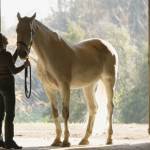Grooming Your Horse: A Quick Health Exam

A daily grooming has lots of benefits. It gives you an opportunity to bond with your horse and reinforce his ground manners. It’s a great way to spot injuries or problems that your horse may be developing. Finally, a thorough grooming of your horse can be a good upper-body workout for you!
But what if you just want to knock off the worst of the mud and go for a quick ride? Not every grooming needs to result in a horse that’s show-ring clean, but you should never neglect this chance to check your horse for lumps, bumps, cuts, heat, or signs of pain. Here’s what to look for:
- If you do nothing else before you ride, pick up each hoof, clean out mud and debris with a hoof pick, and check for heat, injuries, or a smelly discharge from any part of the sole or coronary band. As you run your hand down each leg toward the hoof, feel for heat, swelling, lumps, cuts, or reluctance to picking up the hoof. A horse that won’t raise one foot may have pain in the opposite leg or hoof.
- While you use one hand to brush your horse, run the other hand over his skin to feel for cuts, hairless patches, or tender spots. If you detect any signs of injury or discomfort, check more closely to see what’s causing the problem. Kicking, biting, flinching, pulling away, or dipping the back when it’s touched or brushed can all be indications of pain.
- Look carefully at your horse’s eyes, nostrils, ears, and lips. Check for injuries, discharge, and sunburn. Any area that seems unusually sensitive might signal discomfort.
- Ticks like to attach at the roots of the mane and on the underside of the tail. You might not be able to see them in the mane, but you will easily feel the crusty discharge around the tick bite. Look also for broken hairs near the top of the tail, as this may be a sign of parasites.
- Check the girth area, withers, and any place that is touched by tack or harness. Rubbed, hairless, or raw areas are indications that the tack doesn’t fit well and needs to be padded or adjusted before it is used again.
- Finally, stand back and take a look at the horse as a whole. Is he standing squarely on both front feet? Resting a front foot is often a sign of pain, as is standing with one foot placed out in front of the other; resting a back foot usually doesn’t have the same significance. Look at overall posture also, as a horse that is uncomfortable may hang his head or stand with his feet bunched under him. If anything looks significantly different from what you usually see, evaluate further and call a veterinarian for help if you think your horse needs an examination.








